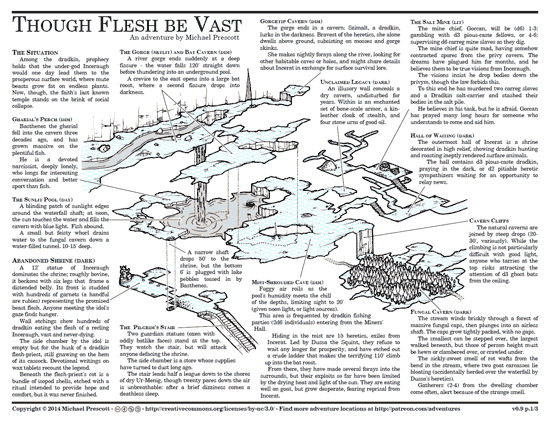In which I propose a campaign structure inspired by John Wick's Dirty Dungeons!
Home on the Range
West Marches style, play starts out with a single explored hex (perhaps a 30-mile hex, it doesn't matter much), and a safe community where the party starts and ends all of their adventures.
Play starts off like Dirty Dungeons. To recap:
- Players decide what the adventure is, by pretending they've researched it extensively in the town's library, wizard's tower or tavern, and explaining what they've learned.
- They take turns describing the threats of the dungeon.
- Minor threats earn them a bonus die, and major threats earn them two. These all go into a pool.
During the adventure, players can use the bonus dice to help themselves out with rolls. (The precise mechanic depends on what game you're playing, it could be Advantage in D&D 5e, or a +1 forward in Dungeon World.)
For every five minutes they spend planning, the GM can introduce a twist - their information is out of date
The GM has the job of stitching this stuff together on the fly, which isn't for the faint of heart but is great fun.
When the adventurers get to the prize they're after, whatever that is, they can use the bonus dice to improve the quality of the treasure. (Again, this will depend on what game you're playing.)
Dirty Journeys
When the players want to do it all again, there's a problem: they've exhausted the adventure potential of the region they've explored. They need to explore!
This works exactly like Dirty Dungeons, except:
- For every four challenges they create, their journey is considered to delve into one new hex.
- The party needs to bring survival supplies: rations and so on.
- Loot (and there's always loot) is incidental. The real payoff is that each hex ventured into reveals a potential adventure location the players can now research.
Now, the players can return to plundering with more Dirty Dungeon missions. The difference is that any travel through the new hexes involves (at the GM's discretion) the challenges that were established, if they weren't somehow defeated during exploration.
These challenges do not come with bonus dice! They just cause problems. In fact, the GM is free to use twists to develop them further - perhaps bandits move into the home hex, or expand their operations, or their bandit shaman summons something nasty. (In Dungeon World parlance, they've become a Front.)
Dirty Quests
If the problems encountered during exploration become too awful to ignore, the players can Quest to deal with them once and for all. Perhaps the bandits need to be driven
This, too, is handled exactly like a Dirty Dungeon - the players design the bandit stronghold (or whatever) in the same way they'd design any other adventure: the players contribute challenges in exchange for bonus dice, and the GM adds any challenges that the party has to travel through.
Bonus dice can be pulled down for advantages, as usual. Loot is incidental to the situation, rather than the goal, and bonus dice are converted directly to XP if the quest is completed. (Though at a lower rate than loot - this is after all a plundering game!)
Other Details
There's probably lots more that can be done with this - two things that come to mind are terrain and settlements.
If the GM is using journey twists to create durable terrain problems ("As you reach the end of the mud flats, you see a mountain range rising up to blue heights and white-dotted peaks.") that force players to move laterally. Particular quests might involve trying to find secret mountain passes, or establishing relationships with communities that could provide guides.
And speaking of communities, while they may be wary at first, parties that prove themselves by accomplishing useful Dirty Quests might be able to establish new places to adventure from, cutting journey times (and dangers) significantly.
What the..
This will of course seem like a weirdly hippie way to plan a campaign, but it's definitely worth a try if you have players who are as stuffed full of ideas as the folks in my home group. The player investment I got from playing a single Dirty Dungeon really surprised me, and as GM, I didn't in the least feel creatively alienated or anything like that.
I'm curious to see what would come of something like this. Send me your ideas!

















